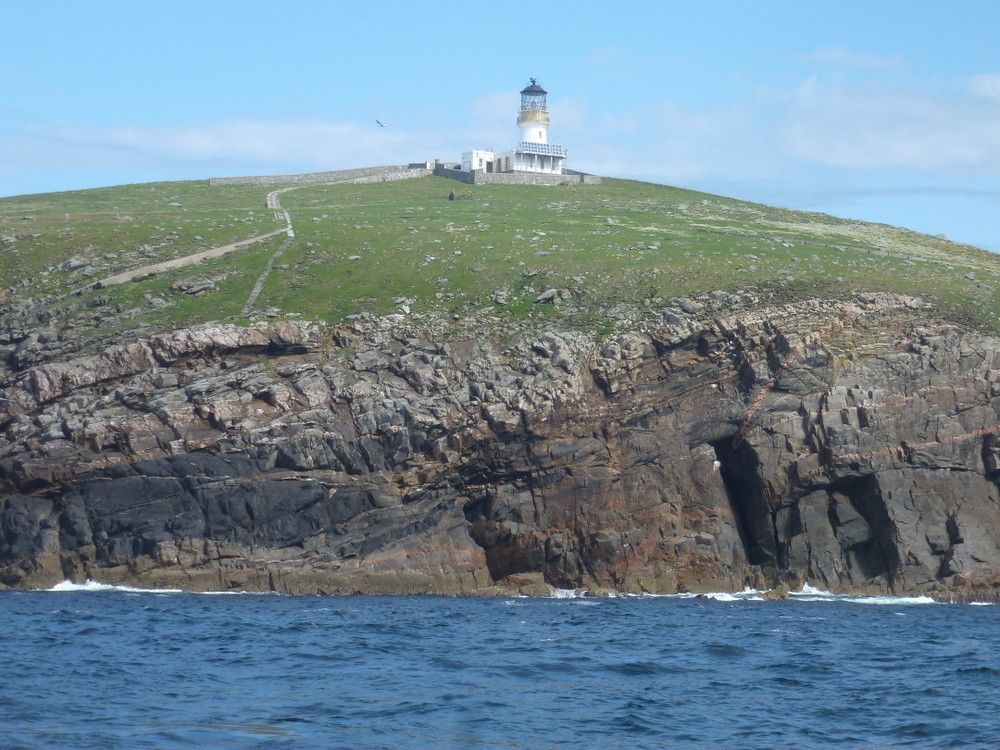During the cold December days of 1900, three men disappeared off a remote island in the Outer Hebrides. They left no trace or trail, save for a chunk of unusual sights: a set yet untouched dinner, an oilskin left behind amid the stormy gale of the Atlantic and a log book recording some strange happenings. These men were the keepers of the lighthouse of Eleanor Mor, a tiny speck in the Flannan Isles near Scotland. Over a century has passed, and no one knows what could have taken away three men in a go.

The lighthouse on Flannan Isles. Photo: XopherD/Flickr
Where It All Began
In 1895 the Flannan Isles lighthouse was erected atop a 150ft high cliff—the first to light up the torrential seas around the islands. The region was inhospitable, but four men managed to station themselves as the watch guards for the tower. These were Joseph Moore, Thomas Marshall, James Ducat, and Donald MacArthur. As the system went, three men always remained at the lighthouse, while one went on a weekly leave on a rotational basis.
All was going well, and a feat was being achieved on a daily basis, until one day there was no light in the sky to mark the success of daily routine. A ship passing by noticed this anomaly on 15 December, and five days later, a boat called Hesperus made its way to the island to deliver supplies and the fourth guard to head back on duty—Joseph Moore. However, the crew was met with an eerie silence in the atmosphere, and the feeling that something was amiss. There was no guard to meet Moore at the shore, and no reaction from the lighthouse that welcomed the docking of the ship.

The missing lighthouse keepers. Photo colourized by Grant Kemp.
“The clocks were stopped and other signs indicated that the accident must have happened about a week ago,” read a telegram from the Captain at the Hesperus. Within the lighthouse, Moore had also found that the oil lamp was clean and ready for lighting, but no one had lit it for days. A table lay set for dinner that was never eaten. Two of the three oilskins were missing, which meant that one of the three guards had set out without his skin in the volatile climate of the Flannan Islands. Why?
Upon a closer look the men realised that something had been brewing for days, if not weeks, on the island. They found the log book that the guards maintained, and it revealed some strange entries. According to Marshall, the island had been under stress from a violent storm unlike any other. He had also logged that during this time Ducat and McArthur were displaying some strange emotional behaviours: while Ducat had been quiet, and the usually tough McArthur had been crying. The final entry of 9am suggested that the storm had ended on 15 December.
How It All Happened
From the date of the last logging it was apparent that the disappearance had occurred on 15 December some time during the day. Moore soon set out to scan the surroundings. The ropes and gear on the East landing were intact, and there was no clue to their disappearance across the length or breadth of the island. On the West landing though, the perplexed crew found that the box that held ropes and moores had vanished. “The iron railings along the passage connecting railway with footpath to landing and started from their foundation and broken in several places, also railing round crane, and handrail for making mooring rope fast for boat, is entirely carried away. Now there is nothing to give us an indication that it was there the poor men lost their lives, only that Mr Marshall has his seaboots on and oilskins, also Mr Ducat has his seaboots on,” wrote Moore in a letter two days later.
Robert Muirhead, who conducted his own investigation on the island later, reported that the lifeboat for emergencies had disappeared, but the untouched ropes suggested that the buoy had been torn apart from its tether by the choppy waves, and not undone to be used by men. He also suggested that the men themselves were blown off the cliff by violent winds.
But the counter to that argument was the question as to why they would have set out into an angry tempest in the first place. Moreover, the log book suggested that the situation was calm on 15 December, the day the light stopped flickering in the sky. Some suggested that a fight broke out, likely triggered by Ducat for being the querulous one. Could it be murder? But that would inevitably have led to at least one suicide. For locals of the archipelago, it was a supernatural force, probably a sea monster, that took the men away. For their inaccessibility and unforgiving terrain, the Isles were considered otherworldly by many. Martin had recorded that the men of Lewis who visited Eilean Mór often observed peculiar customs among themselves.
Despite the mystery, Moore gathered three volunteers and went back to his duties on the island. While maintaining the lighthouse he continued to search for clues about the disappearance. For him, it was hard to fathom how three seasoned seamen who had been maneuvering the cliffs for a year suddenly vanished without a trace. The lighthouse keepers were meant to be tough and experienced, for this particular beacon was among the most uninhabitable, and also the newest. The Flannans were known for their notorious weather, and among them, this lighthouse stood at one of the highest points.
And yet, a hundred and twenty years later, there is still no concrete answer to the mystery.
References:
# Mental Floss
# The Vanishing Lighthousemen of Eilean Mor
# Vice
# Web Archive
# Pan Macmillan












Comments
Post a Comment